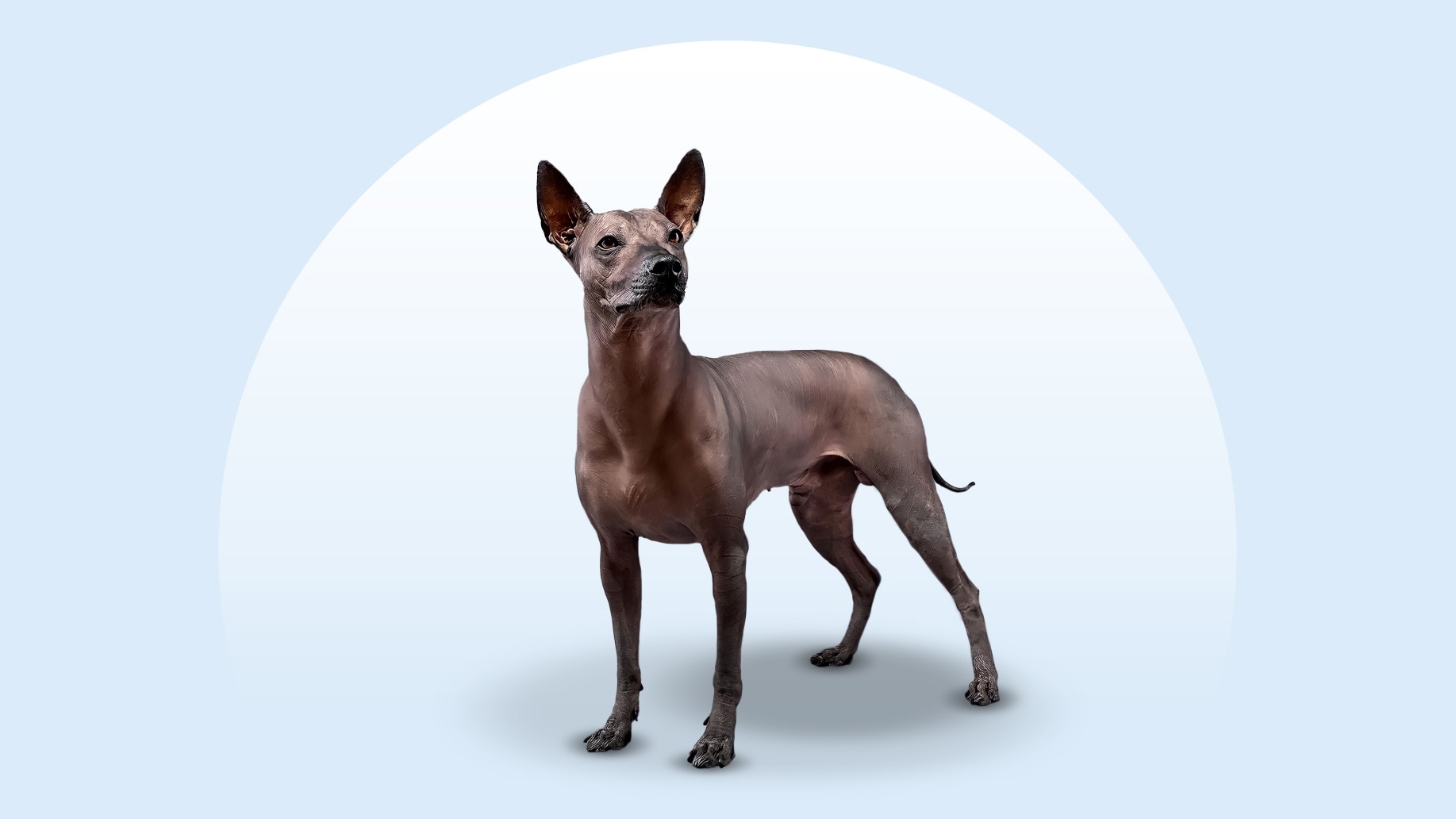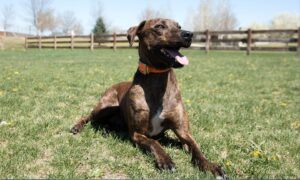Xoloitzcuintli
Updated November 13, 2025
Xoloitzcuintli
Updated November 13, 2025
Xoloitzcuintli dogs are as unique as they are affectionate. This (usually) hairless dog is a rare and ancient breed that originated in Mexico thousands of years ago. These Mexican hairless dogs were considered sacred by the Aztecs, and today they’re revered for their loyalty and intelligence.
Alert, Friendly, Loyal
Toy: 10–15 pounds
Miniature: 15–30 pounds
Standard: 30–55 pounds
Toy: 10–14 inches
Miniature: 14–18 inches
Standard: 18–23 inches
13–18 years
Black, Gray, Bronze, Brindle, Dark Brown, Liver, Palomino, Red, Fawn, Slate, Sable
Looking for a constant canine companion who lives and breathes to be by your side? The Xoloitzcuintli (pronounced show-lo-eats-QUEENT-lee) is an ancient dog breed who expects your full attention at all times.
From errands to the office, it’s best to take your Xolo everywhere you go. Just be prepared to answer everyone’s questions about what type of dog—or even what type of animal—you’ve got with you. This hairless dog breed stands out from the crowd.
Xoloitzcuintli Characteristics
Xoloitzcuintli Appearance
The Xoloitzcuintli is a truly unique dog breed. This lean and sturdy pup is also called the Mexican Hairless Dog for obvious reasons: Most Xolos are hairless, though in rare cases, some have a short, flat coat.
Either way, their rectangular body can be one of three sizes:
- Toy Xoloitzcuintli weigh 10–15 pounds and stand up to 14 inches tall.
- Miniature Xoloitzcuintli weigh 15–30 pounds and stand up to 18 inches tall.
- Standard Xoloitzcuintli weigh 30–55 pounds and stand up to 23 inches tall.

- Ears
Xoloitzcuintli ears are large and set high. They’re thin and delicate in texture.
- Eyes
Xoloitzcuintli eyes are almond-shaped and range from yellow to black.
- Nose
Xolo noses match their coloring—dark on dark-color dogs and lighter on lighter dogs.
- Coat Length
Xolos have two coat types: hairless and coated. The Xoloitzcuintli hairless dog is most common—they have smooth, thick skin that sometimes has patches of hair on top of their head, the end of their long tail, and on the legs and feet. But it is possible to have a Xoloitzcuintli with hair (aka a coated Xoloitzcuintli), whose coat is short and flat.
- Coat Color
With or without a coat, Xolos come in a variety of colors, from black, gray, and dark brown to red, liver (brown), and bronze.
- Tail
The Xolo’s tail is long and fine, set low, and carried in a graceful curve.
Xoloitzcuintli Temperament
Xoloitzcuintli dogs are loyal and loving—so much so, that they’d prefer to be around you 24/7. They might be more aloof with strangers, but if that makes you think for one second that they’re not affectionate, you’re wrong.
Xolos form a strong bond with their favorite person (spoiler: it’s you), and they’ll show the rest of the fam a lot of love, whether it’s tiny humans or four-legged canine pals. This makes this Mexican hairless dog a great family pet.
While they might get along with other pets in the house, as noted, they’re not one to just show up at the dog park and make friends. In fact, it’s important to safely socialize your Xoloitzcuintli puppy from an early age so that they learn to not be so suspicious of everyone.
Their Velcro dog reputation also means that Xolos might get a little sad when they’re away from you, so it’s important to make sure you tend to any separation anxiety.
How to Care for a Xoloitzcuintli
Xoloitzcuintli need a lot of quality time together. Luckily, grooming, exercise, and training can all meet this need for attention.
Grooming
Training
Diet
Exercise
Environment
Xoloitzcuintli Health
The average Xoloitzcuintli lifespan is 13–18 years. They have a reputation for being healthy dogs, but there are some potential issues to be aware of.
- Acne: Young Xolos can develop acne, but they typically outgrow it as they mature. Keep your pup’s skin dry and clean, and see a vet for advice. Some dogs respond well to medicated wipes or shampoos, but your vet can also prescribe anti-inflammatory medications, antibiotics, or antifungals.
- Hip dysplasia: Hip dysplasia is when the ball and socket of the hip and thigh bones doesn’t fit together properly. It’s an inherited condition that can be made worse with obesity, and it eventually leads to arthritis and pain. More severe cases may require surgery, but the condition is often treated with medications, joint supplements, special diets, weight management, and/or physical therapy.
- Luxating patella: Xolos can develop a luxating patella, where the kneecap slips out of place. A bunny hop, skip, or limp could be a symptom. It may be treated with supplements and medication, if mild, though surgery may be necessary.
- Missing teeth: Hairless Xolos are usually missing a few teeth—it’s just part of their genetics, and it’s totally normal. However, it means that you’ll want to avoid anything that’s too hard to chew, and you should watch closely for gum irritation or redness.
- Sunburn: Even though these pups may love the sun, they can burn if they stay out for too long (especially the lighter-colored Xolos). If you’re going to be outdoors for a while, slather on a dog-approved sunscreen.
Xoloitzcuintli History
Beloved by the Aztecs, these pups are thought to be the first dog breed native to the Americas. They were believed to have healing powers and to protect against evil spirits, according to the Xoloitzcuintli Club of America.
Xoloitzcuintli were first recognized by the American Kennel Club in 1887 under the name Mexican Hairless Dog, but they were actually deregistered in 1959 due to their scarcity. It wasn’t until 2011 when the dogs received AKC recognition again, as Xoloitzcuintli.
You might recognize the Xolo from works of art by Diego Rivera and Frida Kahlo, who kept the dogs as pets and often used them as subjects in their paintings.
Xoloitzcuintli have also made a splash in popular culture, with everyone falling in love with Dante the Xolo, the silly, friendly dog in the Pixar film, “Coco.”
The breed is rare, so Xoloitzcuintli puppies tend to cost between $1,500–$3,000. If you choose this route, pick a responsible breeder.
You can also try to find a dog through the breed club’s Xoloitzcuintli rescue, and you may also have luck searching Chewy’s database of adoptable dogs in your area.








